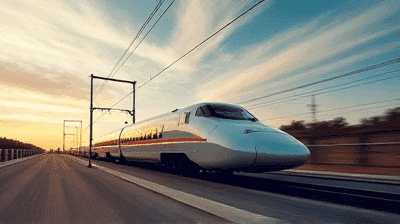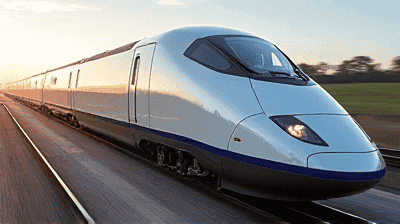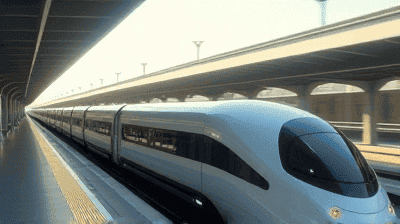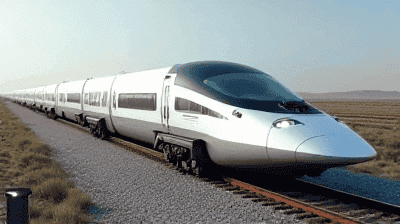
In recent years, the urgency to address climate change and reduce dependence on fossil fuels has led to increased interest in sustainable transportation solutions. As urban populations grow and congestion on roadways and airspace rises, the quest for efficient, eco-friendly alternatives to traditional transportation methods becomes critical. Two innovative modes of transport have emerged as potential contenders to replace short-haul flights: hyperloop systems and high-speed rail.
Hyperloop is a proposed mode of transportation that consists of passenger pods traveling through low-pressure tubes at incredibly high speeds. The concept was popularized by entrepreneur Elon Musk in 2013, and since then, several companies and organizations have been working to develop the technology. Hyperloop aims to provide an ultra-fast, energy-efficient travel alternative, particularly for distances of up to 1,000 kilometers where short-haul flights are currently prevalent.
Vacuum-Sealed Tubes: Hyperloop operates in low-pressure tubes that significantly reduce air resistance, enabling high speeds of up to 760 miles per hour (1,220 kilometers per hour).
Maglev Technology: The pods are designed to float on a magnetic cushion using magnetic levitation (maglev) technology, which reduces friction and increases efficiency.
Renewable Energy: Hyperloop systems have the potential to be powered by renewable energy sources, such as solar power, making them a sustainable alternative to fossil-fuel-dependent air travel.
High Capacity and Speed: Each hyperloop pod can carry a large number of passengers, and multiple pods can operate simultaneously, reducing travel times between cities significantly.
Environmental Impact: By providing a clean, energy-efficient transportation option, hyperloop systems could significantly reduce carbon emissions associated with short-haul flights.
Speed and Efficiency: The potential for hyperloop pods to reach incredible speeds presents an alternative that could compete with or even surpass the efficiency of air travel for short distances.
Reduced Congestion: Hyperloop could alleviate congestion at airports and on highways, providing a streamlined transportation option for metropolitan areas.
Economic Development: By improving connectivity between cities, hyperloop could stimulate regional economic growth and development, leading to job creation and innovation.
Technological Feasibility: While hyperloop is a groundbreaking concept, it remains largely theoretical, with significant engineering and technological challenges to overcome before it can be implemented on a large scale.
Infrastructure Costs: Building the necessary infrastructure for hyperloop, including land acquisition and construction of vacuum-sealed tubes, may require substantial investment and funding.
Regulatory Hurdles: Navigating the regulatory landscape is another challenge, as hyperloop systems will require approvals from multiple governments and regulatory bodies.
Public Acceptance: Attaining public trust and interest in this new transportation mode is crucial; consequently, comprehensive outreach and education will be needed.

High-speed rail (HSR) refers to passenger trains that travel at speeds greater than 155 miles per hour (250 kilometers per hour). Widely established in countries like Japan, France, and China, high-speed rail systems utilize dedicated tracks, advanced train technologies, and efficient energy sources to provide rapid transit between cities.
Dedicated Infrastructure: High-speed trains often operate on dedicated tracks separate from conventional rail systems, allowing for faster and more reliable travel times.
Electrification: Most high-speed rail systems are electrified, enabling them to run on clean energy and reducing reliance on fossil fuels.
Safety and Comfort: High-speed trains are designed with passenger comfort in mind, featuring spacious seating, dining options, and amenities like free Wi-Fi.
Integrated Transport Systems: High-speed rail often connects seamlessly with local transit options, such as metros, buses, and trams, enhancing overall accessibility and convenience.
Environmental Sustainability: High-speed rail is one of the most environmentally friendly modes of transport, producing significantly lower emissions per passenger mile compared to air travel.
Urban Accessibility: High-speed rail enhances regional connectivity, making it easier for people to travel between metropolitan areas without relying on short-haul flights.
Reduction of Traffic Congestion: By transporting passengers efficiently over short to medium distances, high-speed rail can alleviate road congestion and reduce reliance on airports.
Boost to Local Economies: Investing in high-speed rail systems can create jobs, stimulate tourism, and promote economic growth in connected regions.
Capital Investment: Developing high-speed rail infrastructure requires substantial investment, often leading to debates about financing and budget allocation.
Land Acquisition and Right-of-Way Issues: Securing the land needed for new rail tracks and negotiating with landowners can be challenging, particularly in densely populated areas.
Construction Timeframes: Building high-speed rail systems often takes years or even decades, delaying the benefits they can provide to travelers.
Political and Public Support: Achieving the political will and public interest necessary to fund and support high-speed rail projects can be difficult, especially in regions with competing transportation priorities.
Hyperloop: With the potential to reach speeds of up to 760 miles per hour, hyperloop could dramatically reduce travel times between major cities; for example, a journey from Los Angeles to San Francisco could take just over 30 minutes.
High-Speed Rail: While high-speed trains are considerably slower than hyperloop, they still offer rapid travel options. For instance, the journey between Paris and Lyon can be completed in under two hours at speeds of up to 200 miles per hour.
Hyperloop: When powered by renewable energy, hyperloop promises a low carbon footprint. However, environmental impacts related to land use and infrastructure construction must be carefully considered.
High-Speed Rail: High-speed rail is already an established green alternative, producing fewer emissions than cars or planes for equivalent distances. The use of electrification further enhances its sustainability.
Hyperloop: While the concept holds potential for cost savings in operations, the initial investment required for development and infrastructure is significant and can be unpredictable.
High-Speed Rail: High-speed rail projects also require substantial upfront capital, but their long history provides valuable lessons in cost management and project feasibility.
Hyperloop: Building hyperloop infrastructure involves constructing long, straight vacuum-sealed tubes, which can present challenges in urban and mountainous environments.
High-Speed Rail: High-speed rail lines require dedicated tracks, signaling systems, and stations, but existing rail networks can sometimes be upgraded for higher speeds.
Hyperloop: As a novel technology, hyperloop must overcome skepticism and regulatory hurdles before it can gain acceptance.
High-Speed Rail: Established high-speed rail systems have already demonstrated their value, leading to greater public acceptance in regions where they operate.

Both hyperloop and high-speed rail offer compelling advantages for travelers looking for alternatives to short-haul flights, which typically involve a range of downsides:
Time Inefficiency: Although flights may appear quick, the time spent on check-in, security checks, boarding, and disembarking can make short-haul flying more time-consuming than rail or hyperloop travel.
Environmental Impact: Short-haul flights are associated with high per-passenger carbon emissions, contributing to climate change and air quality issues.
Cost: As fares for short-haul flights can vary widely, alternatives such as hyperloop and high-speed rail may provide more predictable pricing.
Investing in Infrastructure: Countries need to consider how existing infrastructure can be integrated with these new modes of transport. Land use planning and investment in new technologies are vital to make these alternative systems viable.
Government Support and Public Funding: Large-scale investments in hyperloop and high-speed rail will likely require significant government support, given their costs and the time involved in developing the necessary infrastructure.
Sector Collaboration: Successful integration of hyperloop and high-speed rail will require collaboration between governments, transportation authorities, and private companies, promoting a cohesive vision for sustainable mobility.
Hyperloop Networks: If developed, hyperloop systems could effectively replace short-haul flights in regions like the Northeast Corridor in the United States, or Europe, connecting major cities with rapid transit times.
High-Speed Rail Expansion: High-speed rail systems like California High-Speed Rail could make air travel unnecessary between cities like San Francisco, Los Angeles, and Sacramento, where short-haul flights currently dominate.
Shinkansen (Japan): The iconic Shinkansen (bullet train) has been successful in connecting major cities across Japan since its inception in 1964, offering rapid transit that has significantly reduced domestic air travel.
French TGV: The TGV (Train à Grande Vitesse) has transformed intercity travel in France, promoting rail use as a preferred alternative to short flights.
Spanish AVE: Spain's AVE high-speed rail systems connect cities such as Madrid and Barcelona, providing a comfortable and efficient alternative to air travel.
Virgin Hyperloop: Virgin Hyperloop carried out successful tests in 2020, demonstrating the feasibility of the technology, although extensive infrastructure development remains ahead.
Los Angeles Hyperloop Proposal: A proposed hyperloop network linking Los Angeles to other California cities, such as San Francisco, aims to address congestion and reduce reliance on short-haul flights.

Multimodal Transport: Future transportation systems may increasingly integrate multiple modes of transit, with hyperloop and high-speed rail playing vital roles in a broader mobility ecosystem that includes buses, trams, and shared mobility options.
Smart Transportation Hubs: To maximize the benefits of hyperloop and high-speed rail, urban planning should focus on developing transportation hubs equipped with technology for seamless passenger transfers.
Electric and Hybrid Innovations: Continued advancements in electric and hybrid technologies may enhance the sustainability and efficiency of both hyperloop and high-speed rail systems.
Automation and AI: The integration of automation and artificial intelligence could improve operational efficiency, safety, and passenger experience in both types of transit.
Governments and transit authorities must prioritize green initiatives, recognizing the vital role that hyperloop and high-speed rail can play in enhancing sustainability. Investment in clean technologies and the commitment to reducing reliance on fossil fuels will be essential drivers of this transition.
Hyperloop and high-speed rail represent promising alternatives to short-haul flights, capable of transforming urban mobility and contributing to environmental sustainability. While both systems face unique challenges and require significant investment, their potential benefits merit serious consideration as communities strive to reduce carbon emissions, enhance connectivity, and improve quality of life.
The future of transportation lies in innovation, collaboration, and an unwavering commitment to sustainability. By embracing hyperloop and high-speed rail, society can forge a path toward a cleaner and more efficient transit landscape, ultimately ensuring a more sustainable and interconnected world.